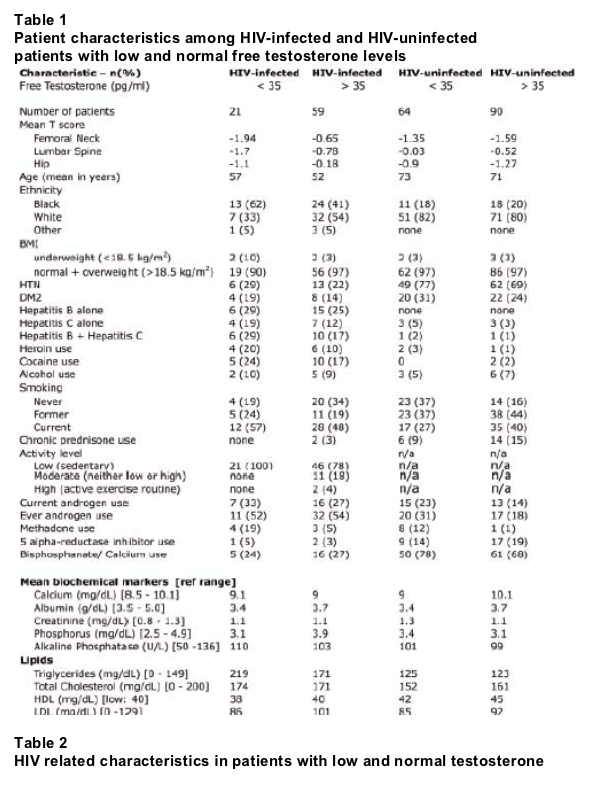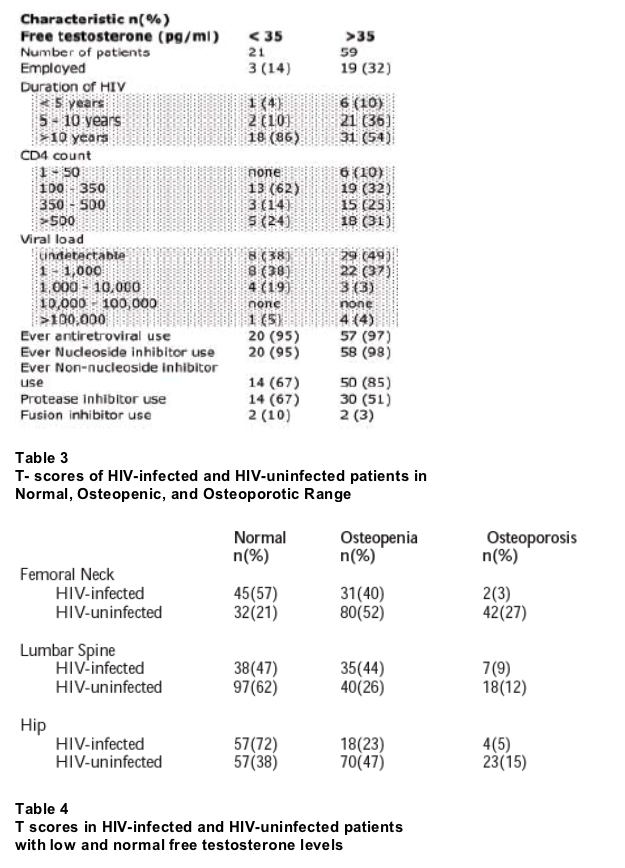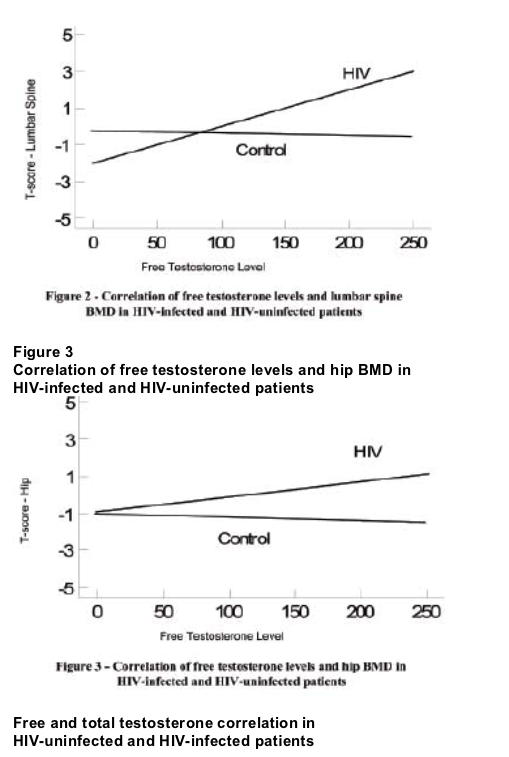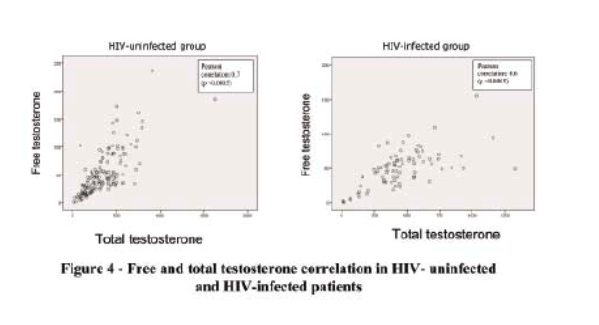 |
 |
 |
| |
Comparative Analysis of HIV+ and HIV- Interaction with Testosterone on Bone Mineral Density
|
| |
| |
Reported by Jules Levin
ICAAC/IDSA Oct 28 2008 Wash DC
R.RAGHUNATHAN 1,2,J.SINACORE 2,K.RYCHLIK 2, J.FARANO 1,C.PACHUCKI 1,2,and N.AZAD 1,2
1 Edward Hines VA Hospital
Hines, VA 60141
2 Loyola University Health System,Maywood, IL 60153
AUTHOR CONCLUSIONS
In age-matched HIV-infected men, a lower free testosterone corresponds significantly to a lower T-score at the lumbar spine.
A normal free testosterone level was protective of bone mineral density in HIV-infected patients compared to the control population.
Among HIV-uninfected men, an increase in free testosterone level does not correspond to an increase in T-scores.
Further studies evaluating the interaction of low free testosterone and HIV infection need to be conducted to better understand the bone-related effects.
Background: Given an increasingly younger HIV population with osteopenia/osteoporosis a retrospective controlled study was conducted to investigate the effects of testosterone on bone mineral density (BMD) in HIV infected and HIV non-infected populations.
Methods: A chart review was done on a group of 80 male HIV patients and 154 male control patients. The following variables were obtained from the HIV group: age, race, employment status, smoking, body mass index (BMI), duration of HIV, CD4 levels, viral load, type of antiretroviral use, co-morbidities, use of prednisone, heroin, alcohol, methadone use, ever use of androgen, bisphosphanate use, calcium use, alpha reductase inhibitor use, phosphodiesterase inhibitor use, lipids, and biochemical markers. The same variables were obtained from the control group except those pertaining to HIV and employment status. T-scores were used in both HIV and control groups to evaluate BMD.
Results: A univariate analysis of variance was used controlling for the following factors: age, race, BMI, prednisone, heroin, alcohol, smoking, methadone, androgen use, alpha reductase inhibitor use, phosphodiesterase inhibitor use, bisphosphanate use, and calcium use.

Conclusions: A normal testosterone level was protective of bone mineral density in HIV-infected patients compared to the control population. At the L-spine, HIV patients with low testosterone had a lower bone mineral density (p < 0.05). Treatment of osteopenia/osteoporosis with testosterone in HIV patients needs further evaluation.
BACKGROUND
Prevalence of osteoporosis in HIV-uninfected hypogonadal men is reported to be 12.3% vs. 6.0% in men with normal testosterone levels1.
Among patients enrolled in the Study to Understand the Natural History of HIV and AIDS (SUN), 52% had osteopenia and 10% had osteoporosis. Among these patients 78% were men, 25% were black, and 80% of patients received antiretrovirals (ART)2.
Up to 70% of treatment-naive HIV-infected men are reported to have low free testosterone3.
Whether an isolated HIV-related hypogonadism interaction plays a role in developing osteopenia/osteoporosis is unknown.
It remains unclear how HIV itself or other known attributable factors (such as age, sex, race, duration of HIV, ART, hypogonadism, etc.) lead to the development of osteopenia/osteoporosis.
There is a renewed interest in the pathogenesis, diagnosis, and management of osteoporosis in this population.
HYPOTHESIS
We hypothesize that patients with HIV with low free testosterone levels have lower T-scores.
METHODS/STATISTICAL ANALYSIS
A retrospective chart review was performed on two groups: 80 HIV-infected men and 154 HIVuninfected men (see Table 1 for epidemiologic characteristics in each population).
HIV-specific information was obtained in those men who were HIV-infected with low and normal testosterone (see Table 2).
An analysis of covariance was done controlling for the following factors: age, race, BMI, smoking, and use of prednisone, heroin, cocaine, alcohol, methadone, androgen, alpha reductase inhibitor, phosphodiesterase inhibitor, bisphosphanate, and calcium (see Figs 1 - 3, Table 4).
The serum free testosterone (FT) levels were measured by Quest diagnostics (using dialysis method Wood Dale II). The normal FT ranges 35 - 210 pg/mL (see Fig 4 for free vs. total testosterone correlations in HIV-infected and HIV-uninfected patients).





REFERENCES
1. Fink H.A., Ewing S.K., Orwoll E.S., et al. Association of Testosterone and Estradiol Deficiency with Osteoporosis and Rapid Bone Loss in Older Men. The Journal of Clinical Endocrinology and Metabolism 2006; 91(10): 3908 - 3915.
2. Calza L., Tampellini L., Chiodo F., et al. Bone Mass Loss in Patients with
HIV Type 1 Infection. Infectious Diseases in Clinical Practice 2007; 15(3):
160 - 166.
3.Wunder D.M., Bersinger N.A., Furrer H., et al. Hypogonadism in HIV 1-infected men is common and does not resolve during antiretroviral therapy. Antiviral Therapy 2007; 12:261 - 265.
|
| |
|
 |
 |
|
|